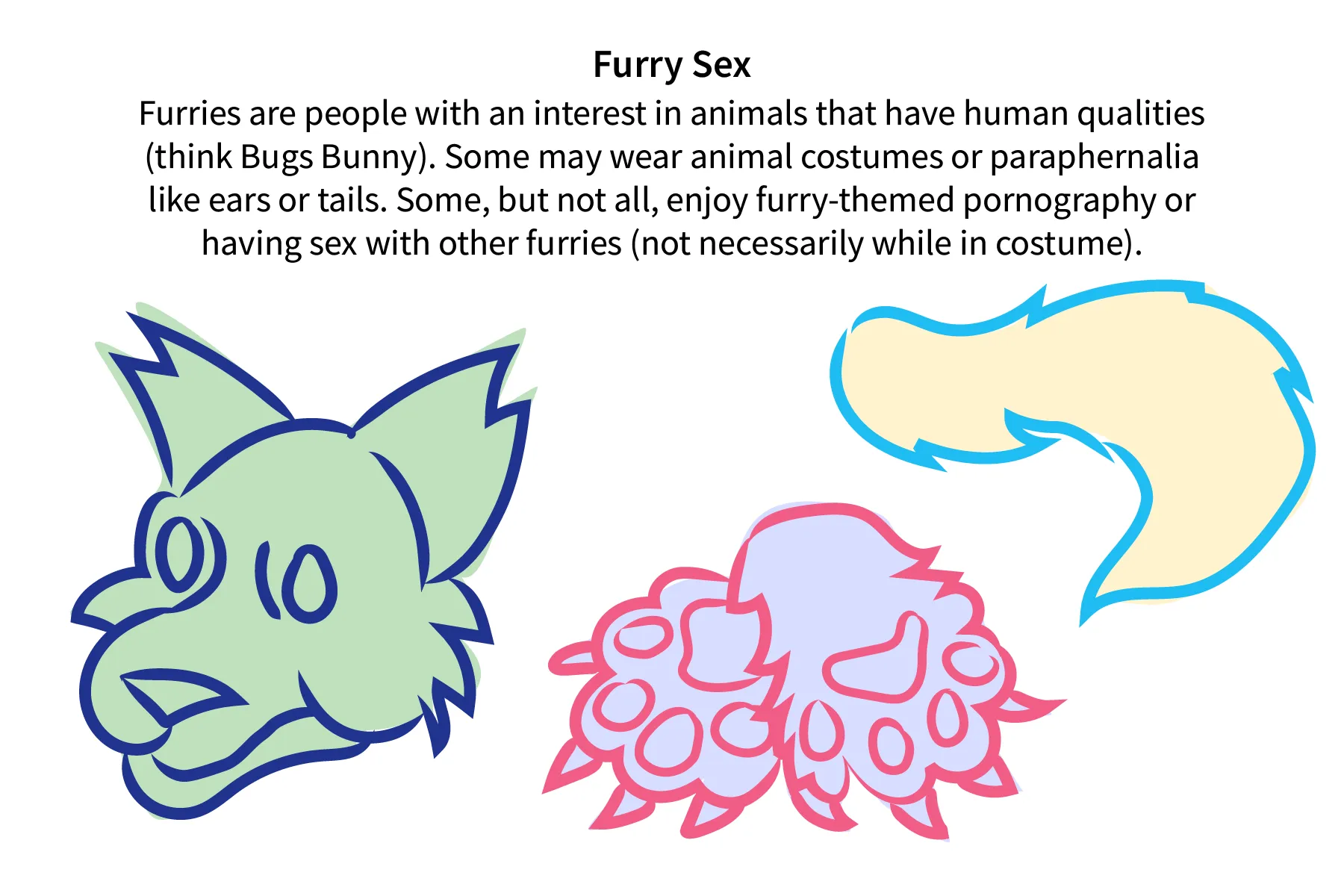What Are Furries?

Furries are people who have an interest in anthropomorphic animals, or animals with human qualities. Many furries create their own animal character, known as a fursona, which functions as their avatar within furry communities.
While fursonas are each based on an animal -- a dog, cat, reptile, bird, wild animal, or even mythical creature--they walk upright like humans do and often have a cartoonlike appearance.
Furries represent their fursonas through art, writing, online identities, or in the creation of "fursuits," which are elaborate costumes depicting the individual's animal. Some fursuits are full costumes, while others are partial, including animal ears, tails, or gloves.
What Is the Furry Fandom?
A fandom is a community of people united by a common interest. In the case of furry fandom, the term describes the whole of furry-dom, meaning those with a particular interest in anthropomorphic animals, such as Bugs Bunny and other cartoon animals that have human qualities.
Furry fandom primarily exists in online communities, but they do meet in person as well, in local groups and at furry conventions. If you are a furry, you are part of the furry fandom. Other terms for this include furrydom, furridom, fur fandom, and furdom.
In addition to gathering online and in person, members of the fandom produce fan art and fan fiction depicting anthropomorphic animals. Costumes called "fursuits"--not unlike the suits worn by sports teams’ mascots--are a part of furry fandom, but only for some furries. In fact, fewer than 15% of furries own full suits, mainly because of the very high cost. The price of a full suit can be between $4,000 and $5,000. Instead, most furries limit themselves to partial fursuits or to "furry paraphernalia," such as fake animal ears or tails.
When it comes to costumes, furry fandom does not differ in basis from other communities that involve taking on different identities. One example could be Civil War reenactors who dress up as Union or Confederate soldiers and get together for mock battles. Cosplayers are another example. They costume themselves as comic book superheroes, villains from Star Wars, or other characters out of science fiction and fantasy.
Some media portrayals of furries have emphasized a strong sexual element to the fandom. But if sex motivates some of the furry fandom, it's hardly the only thing that interests its members. People are drawn to furry fandom for a variety of reasons, including its focus on art, creativity, and community. Some research has found that most furries do have at least some sexual interest in furry-themed content, such as erotic art, but they have only a modest sexual motivation for participating in the furry fandom.
About three-quarters of adults in the furry fandom are under age 25, more than 4 out of 5 are white, and most are male or assigned male at birth. Just over 1 in 4 furries are female or assigned female at birth. About 2% identify as transgender. Just over 20% of furries say they are exclusively heterosexual, and about 10% identify as exclusively homosexual. The rest fall somewhere in between or elsewhere on the sexual spectrum.
The furry fandom thrives in the online space, but many individuals also meet locally or nationally to engage with like-minded fans. Each year, furry enthusiasts meet at conferences across the country.
The community itself is known for its diversity and acceptance. One-third of the furry community identifies as exclusively heterosexual, and furries are 5 times as likely to identify as LGBTQ (lesbian, gay, bisexual, transgender, transsexual, queer, questioning, intersex, asexual, pansexual) than the general population.
How Did the Furry Community Start?
The furry community began to emerge in the 1970s, alongside growing interest in science fiction, anime, and role-playing. You may have heard of Trekkies, the fandom that developed around the sci-fi show Star Trek. Furries came on the scene around the same time.
At first, furries -- who were mostly men -- met up informally to share their interests with each other. The first convention in which furries featured happened in 1977, at a meeting of the Cartoon/Fantasy Organization. In the 1980s, furries began to meet formally at science fiction conventions. Then, in 1989, the first furry convention took place.
Called ConFurence 0, it was organized by Mark Merlino and his partner, Rod O'Riley, both of whom are considered founding members of the furry fandom. It was held at the Holiday Inn Bristol Plaza in Costa Mesa, CA. Some reports put attendance at only 65 people. Today, furry conventions -- which take place worldwide -- sometimes welcome more than 10,000 people.
Benefits of Being a Furry
Sex may be one thing that draws you into the furry community. However, it is far from the only benefit.
- Fitting in. Being part of an inclusive community where you feel welcome -- acceptance is very important to furries -- and where you participate with others who share your interests can boost your self-esteem and make you feel more satisfied with your life. That's true of furry fandom.
- Making friends. Most furries say that at least a few of their friends are also furries. About a third say that many of their friends belong to the furry fandom.
- Falling in love. About 60% of furries say they and their significant other met as furries.
- Putting yourself out there. Being a furry may inspire you to present your chosen identity -- your "fursona" -- to the world in a more outgoing and sociable way than would your non-furry self. That can be a real confidence booster.
- Being true or trying something new. Many furries say that their fursona allows them to have novel experiences, while an equal number say that their fursona represents their ideal self.
- Expressing yourself. Being a furry can help you find ways of self-expression--through making and sharing art, writing, and, if you choose to go that route, your own unique "fursuit."
Disadvantages of Being a Furry
There are some drawbacks to being a furry.
- Bullying. A large number of furries say that they have been physically and verbally bullied.
- Social stigma. Many furries feel prejudice against furries, and large number of furries keep their furry identity a secret from family, coworkers, and others.
- Negative stereotypes. Furrydom is often portrayed as merely a fetish. This may be changing, however. Most furries say that public perception and media portrayal of furries has improved.
- Bad apples. No different than other groups, the furry fandom does have its share of toxic people. In fact, negative interactions and harassment are the top reasons people leave the fandom.
Despite these negatives, research suggests that furries are not more likely to have depression or anxiety disorders than anyone else.
How to Explore Furry Sex
Whether or not you're a furry, sex should follow some ground rules that make it safe and acceptable to those involved. That means consent. All those involved should agree to participate, and that agreement should be clearly communicated, before you have sex or other intimate contact, like kissing.
Along with consent, you need to clearly understand and respect boundaries and expectations. Not everyone wants the same thing as you. And remember: past sexual experiences with someone does not entitle you to have sex with them again. Consent should be given every time.
Also, if your partner says stop, you stop. Starting sex does not entitle you to keep going. Consent must be ongoing.
Finally, verify the ages of your partners before you have sex. Costuming may make it hard to determine if they're old enough to give consent. And some furries don't use their real age in their fursonas.
If you're interested in the furry community, you can explore these feelings in a number of ways.
Furry conventions
You can attend furry conventions, also known as "fur cons." These public events allow hundreds or even thousands of furry fans to attend panels, events, merchandise booths, live music, dance contests, games, and more. Smaller furry community gatherings, called "furry meets," allow local furry enthusiasts to meet and socialize.
Furry websites
In the online space, you can participate in internet forums and chat programs. Whether creating your own fursona, sharing and reading furry content, or chatting with other furries online, the Internet offers new ways to engage with the community.
Role-playing in particular is a way to explore furry sex online. Furries often role-play as their fursonas in the virtual world with other furries. This can be a creative outlet for furries to socialize in a low-stakes environment. For others, it can be a space for sexual exploration.
Takeaways
Furries are people who identify with animals who have human characteristics, like cartoon characters. Over the past several decades, they've formed a growing and inclusive community that offers acceptance, friendship, and the opportunity to express oneself. While some portrayals of furries have focused on sex, furries themselves--like all people--have a large and varied set of interests and motivations.
Furry Sex FAQs
- Is being a furry bad? No. In fact, it has many advantages for participants, such as finding community, making friends, expressing themselves, and much more.
- How big is the furry community? That's a hard question to answer because most furries gather different online communities. There's no one central place where furries go to register and be counted. Estimates have ranged from 100,000 to 2.8 million.
- Are furries based on real animals? No. They are based on animals with anthropomorphic--or human--qualities. Think Bugs Bunny.
- Is being a furry illegal? No!

